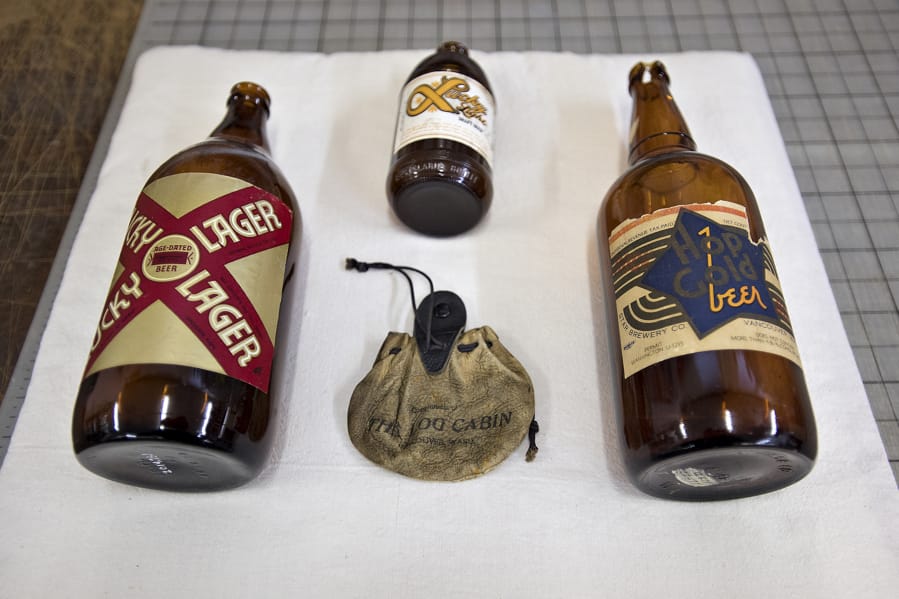Remember when it was illegal to drink alcohol in the United States? The speakeasies, mobsters and robust black market?
Of course you don’t, unless you’re a centenarian. Ordering our favorite cocktails is easy. And speakeasies — well, they’re memorialized in certain bars capitalizing on the novelty for curious millennials. But as we approach the 100th anniversary in January of the short-lived Prohibition era, places like the Clark County Historical Museum are gearing up for a new display of period items, many of which were used locally.
James Kice, 35, manager of collections and operations, recently started selecting alcohol and Prohibition era-related items from the museum’s collection, which is stored in the basement of the museum as well as at an off-site location. Called “History A-Brewin,’ ” it opens in January in the museum’s North Gallery.
Kice’s job is to very, very carefully sift through these items, clean them (but not too much), and prepare them for display. It sounds easy — handling old stuff — but there’s more to it. He graduated from Washington State University Vancouver with a bachelor’s degree in history, but also took courses through the Oregon Museum Association on object handling and conservation, he said.
Kice’s office is in the museum’s basement. Items of significance sat on a long table. Behind the table was a wall full of tools and cleaning instruments.
“I’ve identified, I’d say, 50 items, some of which still have to be assessed,” he said. Each item has a backstory. Kice spends hours researching individual items, trying to trace their origins. Without a story, an artifact is just an old thing.
“If you don’t have the individual story of where it came from and why it’s important, that’s the meaty part of it. That sign there came from the original courthouse here in Clark County,” Kice said, referring to a rusty item that displayed the text: “Talking through bars to prisoners positively prohibited.” “Ira Cresap was the police chief during the Prohibition period, so he would’ve seen a lot of action. He also had quite a reputation. Everything has a background and story. Otherwise maybe it’s just a cool old sign that you saw in an antique store. That’s what really makes a difference.”
The Columbian caught up with the Reno, Nev., native — who has handled items from medical supplies from the 1800s to a violin owned by Ulysses S. Grant — to get an idea of what his job is like.
How’d you land this job? I’ve read that the history field is very competitive.
Oh my gosh. Well, we’re going to spin some yarn here. I grew up in a family who had and still has an old farm in the South, in Mount Olive, N.C. I’ve only visited a handful of times, but my memories of that space — you would go into any room and any piece of furniture or any drawer and there’s something in it from someone else who had lived there before. It wasn’t until I started going to college that I knew I wanted to work in the history field, but I wasn’t sure exactly what I wanted to do. I graduated from WSUV in 2014 with a bachelor’s degree in history and I was like, “What do I do?” besides going and getting my master’s degree, which I wasn’t prepared to do at the time. So, I started to volunteer at the museum doing walking tours and volunteering at the front desk. Then I was hired as the administrative assistant in 2016. The museum had closed that year for renovation and we moved out of the building. I was able to get a lot of object handling and get a crash course in how to safely handle things. I really got to see the vastness of this museum’s collection. It’s the same excitement when I would go through the drawers (at the farm) and find things. It’s the same thing here. It’s just a bigger drawer.
What do you find to be the most challenging part of your job?
Space. Because this institution has collected items for a very long time, we have a lot of them. And our spaces for storage are getting full. In order to move an item, there are other things that need to happen because you want to protect it. You don’t want to add to damage or degradation. It’s like “Tetris,” getting the pieces to fit.
WORKING IN CLARK COUNTY
Working in Clark County, a brief profile of interesting Clark County business owners or a worker in the public, private, or nonprofit sector. Send ideas to Hope Martinez:
hope.martinez@columbian.com; fax 360-735-4598; phone 360-735-4550.
I imagine you learn a lot through each of these exhibits.
It’s not only do I learn history of the overarching theme — Prohibition: When did it start? What were the laws that led into it? How did that affect us individually, locally? These stories — I didn’t grow up here and even if I did, I probably wouldn’t know some of them, and how some of those juicy nuggets can relate to items. A great example is a boat model in the ports exhibit. I thought it was just a model of a boat. I did a little research and found that it’s a model of a real boat that was a passenger ship that was turned into a yacht and sank on its maiden voyage in the Great Lakes. I think those little nuggets are always coming out. Eventually you start to see connections of names that I know, people who settled the area very early and how they knew each other. It brings it to life to me, it’s not just old stuff.
What do you hope for the long term? Do you have dreams of being a curator for a giant institution?
Perhaps. I have always secretly wanted to live in a giant manor house or something ostentatious. I realize in my lifestyle it’s not a possibility. I do have a lot of plans for this collection, there’s a lot to be done. We’ll eventually need to rehouse our off-site storage in a larger building. I’m already thinking about those processes.
Does the job pay well?
You don’t get into this field, particularly at a nonprofit, to make millions of dollars. I do this because it’s my passion. It would be great to have someone throwing cash at me but at the end of the day, there are times when I have a conversation with someone who’s donating something or a patron who comes in. Or (local historian) Pat Jollota. And I’m like, this experience having this conversation about the subject is just so awesome and gives me so much joy and energy. I could just go manage a retail store. I have that background. I’ve been offered that many times, in fact. I don’t want to do that. I don’t care how much you pay me. The sense of satisfaction is night and day. Meeting sales goals is great, but it’s not like conserving Ulysses S. Grant’s violin.




